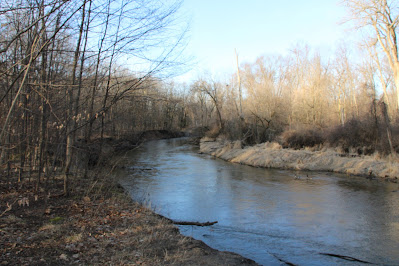It’s early morning with sunny skies and temperatures in the mid 40’s, as I find myself in Mt. Pleasant’s, 46-acre, Veit’s Woods for my weekly nature hike. Following a narrow earthen trail, I’m greeted by the call of a Northern Cardinal, a faithful harbinger of the upcoming season. After crossing a boardwalk lined with leaf-less Red- Osier Dogwood shrubs, I pause at an Austrian Pine tree so see that some of its lower needles have turned yellow. The most likely cause is low soil moisture from long-term drought conditions. Up ahead, I spot a perching Black squirrel, before it scampers up a leaf-less branch. These squirrels are not a separate species, but rather a color variant of the eastern Gray squirrel. It’s evident that their population has increased around here over the past several years. Despite the dark color making it more visible to predators in the winter, it’s the dark fur retaining more heat that gives it a better chance to survive. While moving through a forest of mature, smooth-bark American Beech trees and coarse-bark Red Oak trees, I examine the leaf litter that confirms the proximity of these trees. Next, I come upon a puddle of water while my ears perk up to the distant call of a male Redwing blackbird. First of all, this puddle, referred to as “vernal pool” is an important breeding habitat for salamanders, frogs and toads. Secondly, the call of a male Redwing indicates he has return from his southerly migration and will be establishing a breeding territory before females arrive to mate. Arriving at a high bank of the fast-flowing Chippewa River, I look at a listen to a mating pair of Canada Geese as they announce to other geese that this will be their nesting territory. During the egg-laying and hatching period, the pair will aggressively defend this part of the river. Nearby, two pair of Geese and one pair of Mallards catch my eye. Looking downstream, I watch flowing water move rapidly on the outside curve of this meandering river, creating a steep “cut bank”. Slower moving water on the inside of the meander has less energy, so it creates a “point bar” of sediment. Over time, the continued erosion on the outside and deposition on the inside causes the meander to migrate, or move, across the floodplain. As meanders migrate and grow, they can eventually cut off a loop of the river, creating an "oxbow lake". Turning away from the river and heading back to the car, I notice a Common Privet bush displaying. small, blue berries.. This fruit is mildly poisonous to humans and dogs causing extreme irritation to the hands, mouth and digestive track.
Frigid morning
Sun shines bright
Last days of winter
Landscape not white
Bare branches
Shape the trees
Hanging catkins
Await the leaves
Track of a creature
Marks the ground
Searching for food
Has to be found
D. DeGraaf

No comments:
Post a Comment